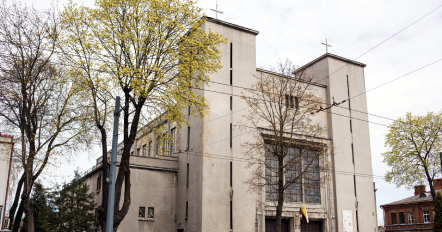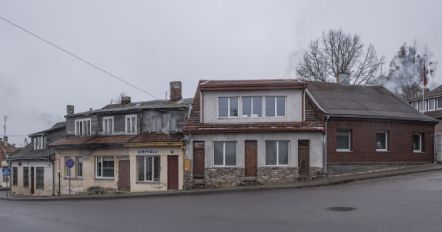Map
This map is designed not only to look for something or explore. You can become an active developer of this map as well. Register a modernist building you live in, mark it on the map and describe it briefly. Even if you do not live in it, but it is your favourite and you are interested in it, become its virtual owner and contribute to its description.

Submit location

Loading
The building`s architecture embodies the goal of uniting the "classical spirit" with the modernism of new times. The building follows a cruciform plan. The large block has a sports hall with a vaulted ceiling of the unique Kreuzekrost construction. Reinforced concrete cofferings are covered by glass…
Between 1934–1935, an intensive construction phase began in Kulautuva. Modern villas and summer houses began to grow along the President's Antanas Smetona Avenue (now Akacijų Alley) and in the surrounding streets. A few of them belonged to businessman Romanas Polovinskas, who has become one of the m…
After the First World War, when the summer resort of Kačerginė and the population grew, the considerations about the construction of the church began. Architect Vytautas Landsbergis-Žemkalnis, who spent his summers in Kačerginė during the interwar period, prepared a unique chapel project in 1936.…
This summerhouse that has some similar features with Swiss wooden architecture was design by famous Lithuanian architect of the interwar period E. Frykas. The owner of this summer house T. Dambravičienė is considered to be one of the founders of Kačerginė resort.…
This villa is important not only as a heritage of wooden architecture, but also for its history. During the interwar period, general Pranas Vaiciuška, a doctor of the Lithuanian Armed Forces, built and spent his family summers in this villa. It was built in 1935 and later in the post-war period hous…
Viktoras Rėklaitis, the director of Kačerginė resort, built a wooden villa in 1934. During the Soviet period there was a dispensary. In 2016 it was decided to restore this building. The administration of Kačerginė eldership is located in the villa, and a branch of the Tourist Information Center is i…
This school had a first-class reputation from the very start because it was built in the vicinity of the envisaged Resurrection Church. For perhaps the very first time in Lithuania the school`s structure followed the progressive principle of functional zoning: the halls for sports and for official f…
The location of the building was determined by its proximity to a source of water, the Nemunas River; and its curved facade was dictated by the need to have space for fire engines. The main curved part of the building contained the garage bays; above them were the fire-station offices and rest areas…
"House with a round window" – this is how it is best known to many Kaunas residents. And although there are many buildings with such windows in Kaunas, nevertheless, the variety of their forms in one building, its exceptional architecture makes it one of the most striking examples of Lithuanian mode…
This primary school in Šančiai was one of the biggest in Kaunas at that time. It is a characteristic building of one of the most productive school designer of the interwar period Feliksas Bielinskis.…
A lot of modern buildings in Šančiai were design by famous Lithuanian architect and school designer Stasys Kudokas. This primary school in Šančiai is one of the signs of modernization in this district.…
This is a sacred building of Romanesque spirit created with modern architectural means. The volume is massive, basilica-like, with two thickset rectangular towers in front. The church`s constructions are of reinforced concrete: the supporting arches and the caisson shell covering the nave.…
During the interwar period Šančiai was one of the city districts that faced the biggest modernization. New schools, factories and infrastructure projects were done here. Šančiai firefighters` building is one of such examples.…
This wooden house belonged to famous Lithuanian writer Kazys Boruta. Currently it is a memorial place of the writer.…
This summerhouse of Landsbergiai family was built in 1938. A green-painted one-story house with an attic became a shelter from bombs falling on the city during the war. After the war, the house was nationalized, and a town pharmacy was established there. Today the house again belongs to the family.…
At first sight this big wooden structure is more a reminiscence of traditional Lithuanian wooden manor than a administrative building, but back in the interwar years it was one of the most significant local institutions in the area.…
After the serious fire in 1938 the whole town center of Vilkija was destroyed. Regardless of big losses and damage, the fire was also a catalyst for modernization. The unique urban plan of Vilkija is still one of the most valuable in Lithuania.…
To have a modern manor outside the city, serving as a prosperous homstead was a popular practice among wealthy people at that time. This modern homestead was built in 1938 by writer and publisher Kazys Puida and his second wife Stefanija Girdvainytė.…
Famous poet and writer Vincas Mykolaitis-Putinas discovered Kačerginė`s resort only in the last stages of his life. He was so happy about this place that together with his wife he desided to move to Kačerginė early in 1960s.…
The professor and botanist of Vytautas Magnus University Liudas Vailionis was a good friend of Tadas Ivanauskas. Once, while hunting, they discovered a nice and peaceful place to live and to create their gardens to experiment with. This homestead is a nice example of an early settler in Kaunas distr…
This villa belonged to Vaiciuškos family that had two villas in Kačerginė. That is the answer why both of them has some similar features, likely designed by the same architect and engineer Pranas Valiukėnas. But there are some nice differences two, the main villa where the owners we staying, is stil…
This villa was build by businessman Romanas Polovinskas in Kulautuva – the modern and popular resort town outside of Kaunas near Nemunas river. It is the only masonry villa in Kulautuva.…
This house was built for the famous painter and chairman of the Lithuanian Riflemen association Antanas Žmuidzinavičius. At first it had two floors; but in 1938, a third one was added: there the artist set up his studio. The family lived on the second floor; the first was rented out.…
The house was built in 1936 under J. Grušas’ project. The writer and his family lived in that house for more than 40 years. Currently it is Juozas Grušas Memorial Museum that was founded in 1989. Visitors have an opportunity to see memorial rooms and various expositions.…
A house, which was owned by the writer Balys Sruoga (1896–1947) and where he and his wife lived from 1938 to 1940 and in 1947. Current – Balys and Vanda Sruogos House-Museum which was opened in 1966. The exhibitions on display reflects the story of Sruogos’ family life and work.…
In this house two famous Lithuanian painters Domicelė and Petras Tarabildos lived.…
This huge and monumental building was a Žaliakalnis jewel. Grandeur was evoked by the broad steps leading to the school from the street. The school`s architectural image is akin to classicism. The building consists of four blocks: the main long one along the street and three wings adjoining on the y…
This building represents, in the best and most clear way, the specific character of our interwar architecture: the harmonious interaction between tradition and modernity. Academic traditions are reflected by the way spaces and plan are structured to emphasize compositional axes and symmetry. This pr…
The construction of the gymnasium started in the summer of 1937 and was completed in September of 1938. The newspapers of that time wrote that the residents of the Lower Šančiai did not like the location of the school, which was in Upper Šančiai: " because their children will have to climb a hi…
Aleksotas Funicular was constructed on the right bank of the Nemunas River was officially opened on 6 December 1935. Authentic traction equipment, including the genuine pre-war wagons, wooden seats, and stop platforms of the funicular are still used.…








 Refine Search
Refine Search






























